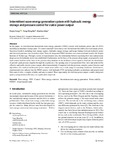Waterbodies thermal energy based systems interactions with marine environment — A review
| dc.contributor.author | Bordbar, A | |
| dc.contributor.author | Georgoulas, K | |
| dc.contributor.author | Dai, Yong Ming | |
| dc.contributor.author | Michele, Simone | |
| dc.contributor.author | Roberts, F | |
| dc.contributor.author | Carter, N | |
| dc.contributor.author | Lee, Yeaw Chu | |
| dc.date.accessioned | 2023-05-02T14:23:32Z | |
| dc.date.available | 2023-05-02T14:23:32Z | |
| dc.date.issued | 2023-12 | |
| dc.identifier.issn | 2352-4847 | |
| dc.identifier.issn | 2352-4847 | |
| dc.identifier.uri | https://pearl.plymouth.ac.uk/handle/10026.1/20779 | |
| dc.description.abstract |
Waterbodies’ thermal energy potential, as a green, renewable, and limitless source of energy, can be exploited in response to the growing energy demands of islands and coastal cities. Up to now, the technologies that have been developed for this purpose include seawater air-conditioning, surface water heat pump, and ocean energy thermal conversion systems or their combinations, which are presented here as Waterbodies Thermal Energy Based Systems (WTEBSs). The growth and development of these technologies raise concerns regarding their potential impacts on sustainability of the marine environment. The present work provides a comprehensive review of the available literature and state-of-the-art technologies describing potential interactions of WTEBSs throughout their life-cycle (i.e. including construction, installation, operation, and decommissioning) with the marine ecology. Modelling of seawater discharge dispersion as one of the main environmental impact concerns regarding the operation of WTEBSs is detailed and scopes for improving existing modelling tools are discussed. Potential destructive impacts of fouling and corrosion in WTEBSs are reported and deterrent recommendations are highlighted. Evidence of growth of bio-fouling inside of pipelines and associated mesh filtration baskets at abstraction pipe intakes are presented. The required permitting applications and licensing processes for installation and operation of WTEBSs by the relevant authorities are summarised. Finally, a summary of the findings from the data monitoring of water quality properties of a seawater air-conditioning pilot study performed at Brixham Laboratory, University of Plymouth, United Kingdom is reported. | |
| dc.format.extent | 5269-5286 | |
| dc.language | en | |
| dc.publisher | Elsevier BV | |
| dc.subject | Renewable energy | |
| dc.subject | Marine thermal energy | |
| dc.subject | Environment impact | |
| dc.subject | Dispersion | |
| dc.subject | Energy resources | |
| dc.subject | Biofouling | |
| dc.subject | Corrosion | |
| dc.subject | Seawater air conditioning | |
| dc.subject | Ocean thermal energy conversion | |
| dc.subject | Surface water heat pump | |
| dc.title | Waterbodies thermal energy based systems interactions with marine environment — A review | |
| dc.type | journal-article | |
| dc.type | Review | |
| dc.type | Journal | |
| plymouth.author-url | https://www.webofscience.com/api/gateway?GWVersion=2&SrcApp=PARTNER_APP&SrcAuth=LinksAMR&KeyUT=WOS:000990245200001&DestLinkType=FullRecord&DestApp=ALL_WOS&UsrCustomerID=11bb513d99f797142bcfeffcc58ea008 | |
| plymouth.volume | 9 | |
| plymouth.publication-status | Accepted | |
| plymouth.journal | Energy Reports | |
| dc.identifier.doi | 10.1016/j.egyr.2023.04.352 | |
| plymouth.organisational-group | |Plymouth | |
| plymouth.organisational-group | |Plymouth|Faculty of Science and Engineering | |
| plymouth.organisational-group | |Plymouth|Faculty of Science and Engineering|School of Engineering, Computing and Mathematics | |
| plymouth.organisational-group | |Plymouth|REF 2021 Researchers by UoA | |
| plymouth.organisational-group | |Plymouth|Users by role | |
| plymouth.organisational-group | |Plymouth|Users by role|Academics | |
| plymouth.organisational-group | |Plymouth|REF 2021 Researchers by UoA|UoA12 Engineering | |
| dcterms.dateAccepted | 2023-04-19 | |
| dc.date.updated | 2023-05-02T14:23:31Z | |
| dc.rights.embargodate | 2023-5-4 | |
| dc.identifier.eissn | 2352-4847 | |
| dc.rights.embargoperiod | forever | |
| rioxxterms.versionofrecord | 10.1016/j.egyr.2023.04.352 |




